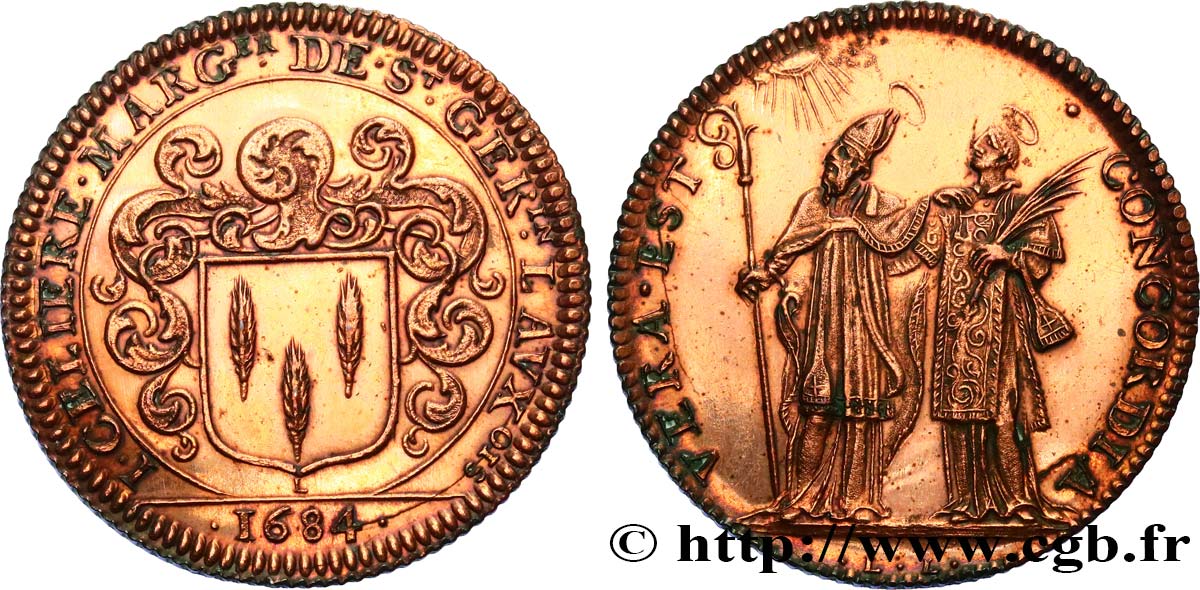fjt_688948 - CHURCHES Saint-Germain-L’Auxerrois 1684
50.00 €约 423.00 CNY
数量
加入购物车

种类 Saint-Germain-L’Auxerrois
日期: 1684
材质 red copper
直径 28 mm
模子方针 12 h.
重量 8,38 g.
侧面 cannelée
印模 sans poinçon
关于品相的说明
nettoyé
出版目录中的项代码 :
正面
正面的文字 I CELLIERE MARGER DE ST GERIN LAVXOIS ; À L'EXERGUE : 1684.
正面的说明书 Armes de J. Cellière.
背面
背面的文字 VERA EST CONCORDIA.
背面的说明书 Saint Germain et un diacre martyr.
背面的翻译 La concorde est réelle.
评论
Refrappe indiscutable. Nous n’avons jamais eu ce jeton en frappe originale.
L'église Saint Germain l'Auxerrois est situé sur la place du Louvre. Fondée vers la fin du VIIe siècle sur un sanctuaire mérovingien, elle fut saccagée par les Normands et reconstruite par Robert II le Pieux en 1010. Elle a ensuite été agrandie ou reconstruite à de nombreuses reprises : la tour romane est du XIIe s., le chœur et le portail sont du XIIIe s., le porche et la nef sont du XVe s. Au XVIe s., l'installation des Valois au Louvre fait de Saint-Germain une église royale. Quelques événements s'y produisirent : les cloches de saint-Germain donnèrent le signal de la Saint-Barthélemy le 24 août 1572 ; le 14 février 1831 l'église est mise à sac suite à une messe célébrée par les légitimistes pour l'anniversaire du duc de Berry ; enfin, chaque année, le 21 janvier, les royalistes y célèbrent une messe en souvenir de la mort de Louis XVI.
L'église Saint Germain l'Auxerrois est situé sur la place du Louvre. Fondée vers la fin du VIIe siècle sur un sanctuaire mérovingien, elle fut saccagée par les Normands et reconstruite par Robert II le Pieux en 1010. Elle a ensuite été agrandie ou reconstruite à de nombreuses reprises : la tour romane est du XIIe s., le chœur et le portail sont du XIIIe s., le porche et la nef sont du XVe s. Au XVIe s., l'installation des Valois au Louvre fait de Saint-Germain une église royale. Quelques événements s'y produisirent : les cloches de saint-Germain donnèrent le signal de la Saint-Barthélemy le 24 août 1572 ; le 14 février 1831 l'église est mise à sac suite à une messe célébrée par les légitimistes pour l'anniversaire du duc de Berry ; enfin, chaque année, le 21 janvier, les royalistes y célèbrent une messe en souvenir de la mort de Louis XVI.








 对产品描述纠错
对产品描述纠错 打印
打印 分享我的选择
分享我的选择 提问
提问 Consign / sell
Consign / sell
 产品介绍
产品介绍















